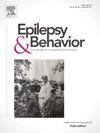Characterising seizure cycles in pediatric epilepsy
IF 2.3
3区 医学
Q2 BEHAVIORAL SCIENCES
引用次数: 0
Abstract
Background
Multiday cyclic patterns underlying the timing of seizures are well-established in adults with epilepsy. However, longer-term patterns underpinning these models are yet to be explored extensively in pediatric cohorts. This study aims to identify and compare multiday seizure cycles between pediatric and adult cohorts, followed by a preliminary validation of cycle-based methods for estimating seizure likelihood in a pediatric cohort.
Methods
Multiday seizure cycles were extracted retrospectively from 325 (71 pediatric) electronic seizure diary users with confirmed epilepsy. Cycles were grouped (k-means clustering) and seizure cycles quantified (synchronisation index) with significant cycles identified (Rayleigh test (p < 0.05)). Wilcoxon rank-sum test assessed differences in prevalence and strength of cycle groups between pediatric and adult cohorts. The accuracy of cycle-based models to track pediatric seizure occurrence was calculated from the receiver operating characteristic (area under the curve; AUC) comparing estimated cycles to shuffled surrogate data and further validated with a moving average model.
Findings
30,019 seizures (pediatric: Median = 51, IQR (Q1 = 30, Q3 = 115), Range (21–661), adult: Median = 46, IQR (Q1 = 31, Q3 = 93), Range (20–1112) were analysed and seizure cycles grouped across circadian (0.5–1.5 days), about-weekly (2–12 days), about-fortnightly (13–22 days) and about-monthly (23–32 days) periodicities. Significant cycles were identified in each cycle group, with no differences in prevalence or cycle strength between pediatric and adult cohorts. Estimated cycles showed a reliable assessment of observed seizure occurrence (significantly (p < 0.05) better performance compared to random models for 88% (44 of 50) and moving average models for 50% (25 of 50) of observed daily seizure occurrence).
Significance
Multiday seizure cycles estimated from seizure diaries present a viable model for identifying longer-term seizure patterns in a pediatric cohort. Knowledge of these individual seizure cycles has potential to reduce the unpredictability of seizure timing and inform clinical decision-making.
儿童癫痫发作周期特征
背景:在成人癫痫患者中,癫痫发作时间的多日循环模式已经确立。然而,支持这些模型的长期模式尚未在儿科队列中广泛探索。本研究旨在确定和比较儿童和成人队列的多日癫痫发作周期,随后对基于周期的方法进行初步验证,以估计儿童队列中癫痫发作的可能性。方法回顾性分析325例(71例)小儿确诊癫痫的电子发作日记使用者的多天发作周期。周期分组(k-均值聚类),癫痫发作周期量化(同步指数),识别显著周期(瑞利检验(p <;0.05))。Wilcoxon秩和检验评估了儿童和成人队列之间周期组的患病率和强度的差异。基于周期的模型跟踪儿童癫痫发作的准确性是根据受试者的工作特征(曲线下面积;AUC)将估计周期与洗牌的替代数据进行比较,并进一步使用移动平均模型进行验证。分析了30,019例癫痫发作(儿童:中位数= 51,IQR (Q1 = 30, Q3 = 115),范围(21-661),成人:中位数= 46,IQR (Q1 = 31, Q3 = 93),范围(20-1112),癫痫发作周期按昼夜节律(0.5-1.5天),约每周(2-12天),约每两周(13-22天)和约每月(23-32天)周期分组。在每个周期组中都确定了显著的周期,儿科和成人队列之间的患病率或周期强度没有差异。估计周期显示了观察到的癫痫发作的可靠评估(p <;0.05)与随机模型相比,88%(50人中有44人)和50%(50人中有25人)的移动平均模型表现更好。意义:从发作日记中估计的多天发作周期为儿科队列中识别长期发作模式提供了一个可行的模型。了解这些个体发作周期有可能减少发作时间的不可预测性,并为临床决策提供信息。
本文章由计算机程序翻译,如有差异,请以英文原文为准。
求助全文
约1分钟内获得全文
求助全文
来源期刊

Epilepsy & Behavior
医学-行为科学
CiteScore
5.40
自引率
15.40%
发文量
385
审稿时长
43 days
期刊介绍:
Epilepsy & Behavior is the fastest-growing international journal uniquely devoted to the rapid dissemination of the most current information available on the behavioral aspects of seizures and epilepsy.
Epilepsy & Behavior presents original peer-reviewed articles based on laboratory and clinical research. Topics are drawn from a variety of fields, including clinical neurology, neurosurgery, neuropsychiatry, neuropsychology, neurophysiology, neuropharmacology, and neuroimaging.
From September 2012 Epilepsy & Behavior stopped accepting Case Reports for publication in the journal. From this date authors who submit to Epilepsy & Behavior will be offered a transfer or asked to resubmit their Case Reports to its new sister journal, Epilepsy & Behavior Case Reports.
 求助内容:
求助内容: 应助结果提醒方式:
应助结果提醒方式:


